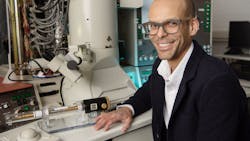Researchers at the University of Illinois at Urbana-Champaign and Sandia National Laboratories have devised a new way to test microscopic sized samples of aeronautical materials at ultra-high temperatures. This lets scientists evaluate materials much more quickly and inexpensively than with traditional testing.
A decade ago, advancements in aeronautical materials involved testing large, expensive models and years of development. Scientists and engineers now use micro-scale experimentation to create new materials and understand the chemical and physical properties that cause material failures. Micro-scale mechanical testing lets researchers break materials down into their components and observe defects at the atomic level. But until now, researchers have been unable to conduct successful micro-scale materials tests at the extreme temperatures experienced by critical components during flight.
Unfortunately, it’s difficult to perform experiments with new materials or combinations of existing materials at ultra-high temperatures above 1,000°C. The testing mechanisms destroy themselves.
This temperature barrier has slowed development of materials for commercial applications such as rockets and vehicles, which must be tested at temperatures well above the current research’s limit of a few hundred degrees Celsius.
The new ultra-high temperature methods use a transmission electron microscope (TEM) and targeted laser heating to see and control where and how the material deformed at the highest temperature possible before the sample evaporated.
The research team brought the laser together with the mechanical tester so precisely with the TEM they can heat samples without overheating the test equipment. With it, engineers can grow a thin film of the material without special processing and put it in the microscope to test a number of different mechanical properties.
As proof of concept, the team tested zirconium dioxide, a material used in fuel cells and thermal barrier coatings, at temperatures up to 2,050°C—a temperature well above anything that could be done.

